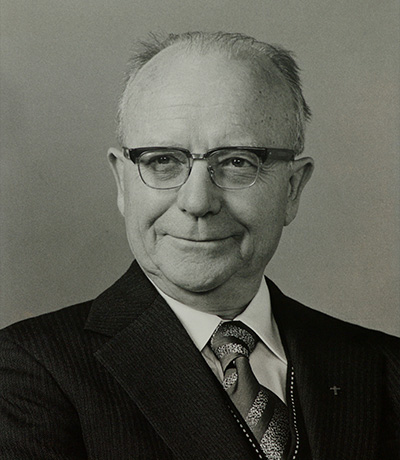Founding and History

Origin of the Eiko Gakuen School Name
AD MAIOREM DEI GLORIAM
Before the word gakuen, meaning "academy," is the word eiko, meaning "glory." Eiko is derived from the motto of the Society of Jesus, a Catholic order more commonly known as the Jesuits: Ad maiorem Dei gloriam (To the Greater Glory of God).
Eiko is written with two Chinese characters, ei (栄) meaning "prosperity" or "glory"and kō (光) meaning "light"; hence, the light that pierces the darkness and shines into the world to bring hope of salvation. Eiko signifies that the life of ministry, of stewarding the blessings of nature bestowed by God to achieve a more sincere, beautiful and abundant world, is the true purpose of mankind. The character 榮 which appears on the Eiko Gakuen school badge is an older version of the character 栄.
Establishment of the School

Eiko Gakuen was founded by the Society of Jesus, a religious order of the Catholic Church founded in 1540 by St. Ignatius of Loyola, St. Francis Xavier and others. In their more than 400 years of history, the Jesuits have undertaken countless educational activities in every part of the world.
In the 16th century, when Christianity arrived in Japan, the Jesuits were early arrivals, setting up schools in places such as Arima and Azuchi. These were soon shut down, however, when Japan’s Shogunate government banned Christianity.
The ban marked the beginning of over 200 years of national isolation. The Society of Jesus was only re-admitted to Japan in the closing years of the Meiji period (early 20th century). The Jesuits founded Sophia University in Tokyo in 1913, following with Rokko Gakuin Junior and Senior High School in Kobe in 1938, and in 1947 our own Eiko Gakuen, on the site of an old navy yard in Taura, City of Yokosuka, Kanagawa Prefecture.
Next, the Jesuits founded Hiroshima Gakuin Junior and Senior High School in Hiroshima in 1956. In 1983 the religious order established Taisei Junior and Senior High School (now Sophia Fukuoka Junior and Senior High School) in Fukuoka. Sharing a common educational ideal, each school marshals its own unique traditions as it continues to respond to the challenges of each era.
At the time of the School’s foundation, the Second World War had just ended. Eiko Gakuen’s first principal, a German priest named Gustav Voss, along with his fellow Jesuits and their students, found themselves in turbulent times. Determined to train a generation of outstanding young Japanese men to shoulder the challenges of the new Japan, Father Voss and his faculty worked day and night to build, furnish, and equip the school, at a time when every kind of material was in short supply. Thanks to their many labors, that early faculty succeeded in instilling the spirit and crafting the unique educational approach that Eiko Gakuen continues to uphold to this day.
To provide students with a better learning environment, in 1964 Eiko Gakuen moved to its current location, a spacious plot surrounded by the bounty of nature in the Tamanawa district of the City of Kamakura, Kanagawa Prefecture. This prescient move provided the cornerstone for further growth.
From just two classes with 72 students in its first year of operations, the School has grown to a present-day operating scale of 24 classes serving 1,080 students (45 students per class, four classes per school year, six school years). The total number of graduates now exceeds 10,000.
History
| March 1947 | Eiko Gakuen Junior High School is founded in the Taura district of the City of Yokosuka. Gustav Voss is appointed as principal.  |
|---|---|
| April 1947 | Eiko Gakuen Junior High School holds its first entrance ceremony (two classes, 72 students). |
| March 1950 | Eiko Gakuen Junior High School holds its first graduation ceremony. |
| April 1950 | Eiko Gakuen Senior High School holds its first entrance ceremony (two classes, 58 students) |
| April 1952 | All school years are filled in both the Junior High School (473 students) and the Senior High School (273 students). |
| March 1953 | Eiko Gakuen Senior High School holds its first graduation ceremony (49 graduates). |
| April 1957 | Eiko Gakuen Junior High School and Eiko Gakuen High School each adopt a four-class configuration (total of 989 students). |
| June 1957 | Eiko Gakuen celebrates the 10th anniversary of its foundation (a hut is built and the Brass Band Club is founded in commemoration). |
| July 1957 | The Eiko Hut is completed in Tanzawa-fudakake.  |
| July 1959 | Eiko Umi-no-Ie ("Sea House") is completed in Moroiso, City of Miura.  |
| July 1964 | Eiko Gakuen moves from the Taura schoolhouse to the new Ofuna schoolhouse.  |
| June 1967 | Eiko Gakuen celebrates the 20th anniversary of its foundation (an en-tout-cas (clay and crushed-brick) track is built in commemoration). |
| April 1977 | Gustav Voss retires as principal; Masaru Tamita is appointed in his place. |
| June 1977 | Eiko Gakuen celebrates the 30th anniversary of its foundation (an all-weather tennis court is built in commemoration). |
| July 1981 | Umi-no-Ie in Moroiso is refurbished and a seaside classroom is completed (closed in 2012). |
| June 1987 | Eiko Gakuen celebrates the 40th anniversary of its foundation (the sports ground is refurbished in commemoration). |
| April 1988 | Masaru Tamita retires as principal; Shuzo Tsukurimichi is appointed in his place. |
| September 1992 | A fine-art classroom and a technology classroom are completed. Aloysius Hall is completed. |
| April 1997 | Eiko Gakuen celebrates the 50th anniversary of its foundation (a multi-function school building, a second gymnasium and baseball diamond are built in commemoration). |
| April 1998 | Shuzo Tsukurimichi retires as principal; Etsuo Sekine is appointed in his place. |
| April 2009 | Etsuo Sekine retires as principal; Yoshimitsu Kaneko is appointed in his place. |
| May 2011 | Shuzo Tsukurimichi retires as chairman; Motoi Kayaba is appointed in his place. |
| April 2015 | Yoshimitsu Kaneko retires as principal; Shinichiro Mochizuki is appointed in his place. |
| April 2016 | The incorporated educational institutions of Sophia University, Rokko Gakuin, Hiroshima Gakuin, Taisei Gakuen and Eiko Gakuen merge. Motoi Kayaba retires as principal; Toshiaki Koso is appointed in his place. |
